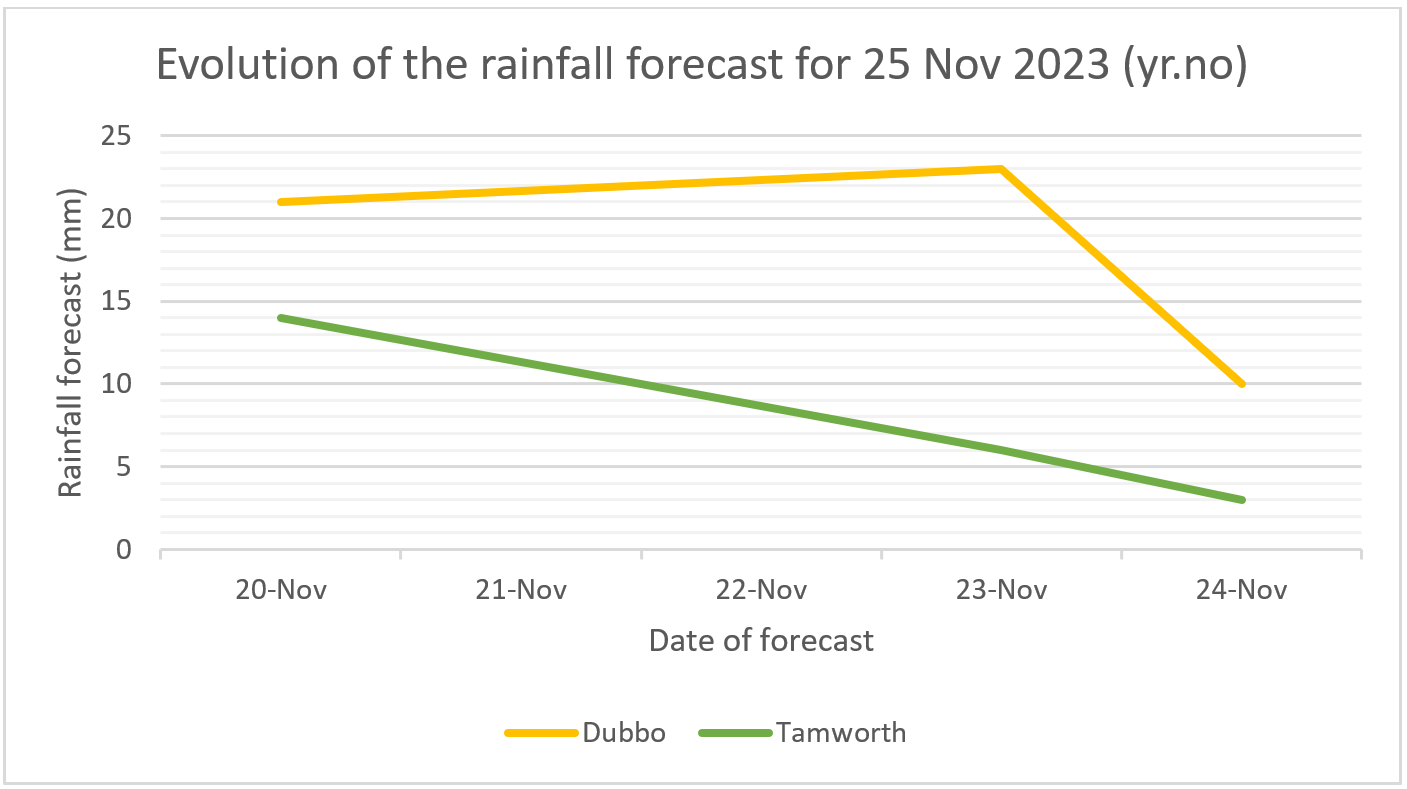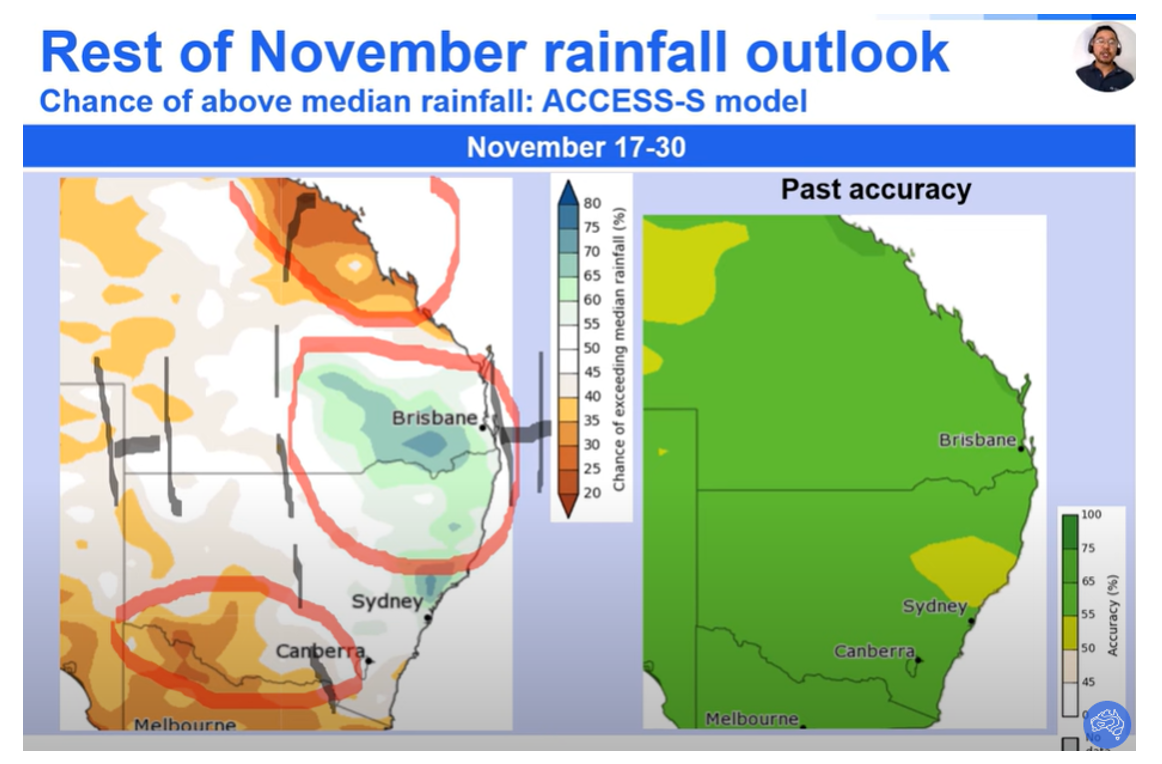Weather predictions, risk and decision making. Perspectives on making better decisions on risk management from weather and seasonal forecasts.
Author: Claire Yeo (Bureau of Meteorology) | Date: 15 Feb 2024
Take home message
- The Bureau of Meteorology's Agriculture Program has been engaging with the grains industry and responding to feedback from growers and advisers since 2017. Research and face-to-face engagement has shown that there is a need for insights that connect short-term weather forecasts to long-term climate forecasts for risk management and decision making.
- With funding from Agricultural Innovation Australia, through investment from the Grains Research Development Corporation (GRDC) and other rural Research and Development Corporations (RDCs) via the Agri-Climate Outlooks (ACO) project, a dedicated service has been established which publishes region and commodity-specific forecasts on YouTube to assist with understanding of long-term outlooks beyond 7-days. . The Agriculture Program delivering the Agri-climate outlooks project aims to positively impact on-farm business management and grains-specific decisions such as autumn sowing.
- The insights captured by the Agriculture Program and continued engagement with industry have shaped the decision support service to date. The case studies presented outline the value of drawing on the expertise of the Bureau, which in turn helps to ground truth the long-term forecast for improved accuracy.
- As growers and advisors plan for the upcoming autumn season and decisions, the Agriculture Program will continue to provide relevant insights that bridge the gap between short-term forecasts and long-term forecasts. We invite growers and advisors to keep up to date with the analysis of the forecasts, by subscribing to the grain’s climate video briefings (Bureau of Meteorology Agriculture YouTube playlist), and by getting in touch with the team via email at agriculture@bom.gov.au, or in-person at field days and seminars
Results
The Agriculture Program has recently increased its service to the agriculture sector, with investment in the Agri-Climate Outlooks (ACO) project from the agriculture industry and other RDCs, including GRDC, to support a decision support service tailored to the agriculture sector. Research conducted by the Agriculture Program has found that there is a need for weather and climate insights that provide additional perspectives when making risk management decisions.
Based on this need, the decision support service aims to provide advisers and growers a comprehensive risk assessment for weather and climate decision-making specifically. This objective is achieved through analysis and research that includes verification and case studies of weather and climate events utilising expertise within the Bureau.
The decision support service, through understanding the complex science of weather and climate, aims to provide targeted advice for high-value agriculture decisions.
This is demonstrated in a specific NSW case study from November 2023 (see below). This case study demonstrates the limitations of using one source without meteorological analysis or understanding of the biases within the computer modelling systems for weather and climate risk assessment.
Case study: Storm outbreak across eastern Australia – November 2023
Agriculture Program staff attended the Cropping Solutions Seminar in Narrabri in July 2023. Through conversations with growers and advisers at the seminar and on the ground, we learned that Yr.no is a popular online resource for grain growers in New South Wales as it provides an 'exact' expected rainfall amount up to 10 days ahead. However, there is not a widespread understanding of how these forecasts are produced, which can limit their effectiveness in decision making.
An example of this came from canola growers near Narrabri that relied on this online source of information for a rainfall forecast more than 7 days in advance. These growers made decisions to sow 1,000ha of canola based on this one rainfall forecast. As the day of the forecast rainfall approached, the rainfall expectation fell dramatically (from over 60 mm to just 2 mm) and this resulted in significant losses due to non-viable crops.
In contrast, the Bureau's 7-day forecast uses a blend of computer models that have been analysed by meteorologists, and so the rainfall forecast shows a probable range rather than one single rainfall amount. Beyond 7-day forecasts, the Bureau's ACCESS-S climate model displays long-term forecasts that show rainfall totals for a given level of chance, and various other displays, for example the chance of exceeding a certain rainfall amount over 3 days. Long-term forecasts are probability-based and are designed to be used as one of several planning tools within risk management and decision-making. The greatest benefits of using Bureau long-term forecasts will accrue from use over several seasons or years. The decision support service aims to make the long-term forecasts more useful for farmers. For example, it uses a range of long-term forecasts that include other international models as part of the analysis to provide a forecast beyond 7 days.
A case study has been developed to demonstrate the effectiveness of forecasts from Yr.no, in November 2023. This was to demonstrate how one model forecast can change significantly over time and therefore not provide the best decision outcome if used in isolation without long-term analysis and verification. In late November 2023, several surface troughs combined with tropical moisture to produce rain and storms over eastern Australia, peaking on 24–25 November. to investigate this, an analysis of forecasts displayed on Yr.no was undertaken and captured how the forecasts changed at Dubbo and Tamworth, and then compared these to observed rainfall amounts.
Forecast on Yr.no
Figure 1 shows how the forecast for 25 November evolved for Dubbo and Tamworth between 20 November (5 days before the storm event) to the day prior.
At Dubbo (top line) the forecast indicated more than 20 mm until 24 November, at which point the forecast fell to 10 mm. Similarly in Tamworth (bottom line), the forecast rain amount dropped in the lead up to 25 November.
The reason why the Yr.no forecast jumped around is because thunderstorms are localised events and are spatially much smaller than the grid resolution of many models. Computer models only give the forecast for a point location based on how the model has resolved precipitation at that grid point. However, actual observed rain may form 5 or 50 km away. A computer model should be viewed as simulating the environment.
Figure 1. Evolution of the forecast at two different locations on yr.no (taken from yr.no between 20-24 November 2023)
Bureau of Meteorology forecast
The grains climate video update (November Grains Climate Outlook - NSW & Qld – YouTube), released on 8 November 2023, discussed the increased risk of rain and storms across eastern Australia more than 2 weeks in advance, during the second half of the month, due to surface troughs and moisture from the north. This included annotations within the video which helped to explain the outlook and provide context. Specifically, the video stated that "the inland trough over inland parts of Queensland and NSW… [would] lead to an increase in shower and thunderstorm activity. Figure 2 shows a screenshot lifted from this video.
This video update went further and compared both the Australian ACCESS-S climate model, as well as the international range of long-term climate models. By doing this, we provided a scientifically rigorous method of analysis, in addition to a meteorologist's understanding of the interactions of weather systems, such as airmass evolution and surface low pressure troughs.
Figure 2. Grains video briefing screenshot from 8 November 2023 (taken from YouTube -November Grains Climate Outlook - NSW & Qld - YouTube)
Rain observations
Rain observations on 25 November 2023 were as follows:
- Dubbo 0.2 mm
- Tamworth 31 mm
Thunderstorms developed during the day and swept over parts of the Murray-Darling Basin. The Bureau issued Severe Thunderstorm Warnings for broad areas of NSW. Figure 3 demonstrates how some locations received high totals, for example Wellington, NSW (38 mm) while others nearby received very little, for example Dubbo (0.2 mm), which is 46 kilometres from Wellington.
Figure 3. 24-hour rainfall totals for 25 November 2023 (observations taken from www.bom.gov.au)
Findings and conclusion
To gain a fuller perspective on weather and climate for risk management decisions, it is important to consider additional analysis, rather than to rely on one popular online resource. Some online resources can be popular as they provide the information presented in a way that is easy to understand or gives a direct solution to a complicated and evolving science, without rigorous assessment. Over-reliance on resources that provide a quantitative numerical forecast outcome based on one model only, without analysis or verification, can increase the error in decision assessment or risk analysis. This is demonstrated in the above example of canola sowing in northern NSW, and the case study of the outcome from the popular website, yr.no.
Different computer models have their individual biases due to model resolution, grid scheme and physics all attempting to simulate the atmosphere and project forward in time. Interpolation of spatial and temporal extent varies. The atmosphere is a complex fluid, and scientists understanding of the physics is constantly evolving, helping to improve the development of models. Feedback continually collected by the Bureau from farmers assists in prioritising future service improvements. While these models will improve into the future, there will always been uncertainty in long-term forecasts due to the complexities in the atmosphere.
The Bureau therefore uses a blend of computer models to provide a rigorous analysis. In particular, the Bureau's meteorologists can provide insights that connect the physical interactions of the atmosphere to modelled scenarios, with the objective of providing the best information to support weather dependant agriculture businesses to understand weather and climate related risk scenarios. The role of meteorologists is to understand the complex science of weather and climate and provide information tailored to the agriculture sector to support on-farm high-value decisions.
The Agriculture Program will continue to engage with the agriculture industry on an ongoing basis, and identify opportunities, such as through the Agri-climate outlooks project to provide direct relevant weather and climate analysis and insights tailored to the needs of the agriculture sector. The insights captured from the agriculture sector will inform research to understand model bias, verification, and model physics in international climate models where appropriate. The team invite growers and advisors to keep up to date with the analysis of the long-term forecast, by subscribing to the Grains Climate Outlook video briefings, and by contacting the Agriculture Program via email at agriculture@bom.gov.au, or in-person at field days and seminars.
Acknowledgements
The Bureau of Meteorology, in partnership with Agricultural Innovation Australia (AIA) are delivering the ACO project, which involves collaboration across 10 rural Research and Development Corporations.
The research undertaken as part of this project is made possible by the significant contributions of growers through both trial cooperation and the support of the GRDC, the Bureau would like to thank them for their continued support.
References
Bureau of Meteorology Agriculture YouTube playlist.
Yr.no. Linked accessed 20-25 November 2023.
November Grains Climate Outlook - NSW & Qld - YouTube
Contact details
Claire Yeo
Bureau of Meteorology
700 Collins St Docklands 3008 Vic
Ph: 0477 520 760
Email: Claire.Yeo@bom.gov.au
Date published
February 2024
GRDC Project Code: AGI2206-002OPX,
Was this page helpful?
YOUR FEEDBACK



